CURRENT RESEARCH TOPICS
Turbulent dilute jet-sprays laden with evaporating droplets
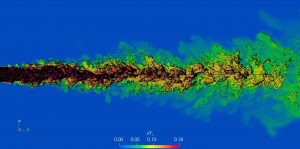 Turbulent jet-sprays are complex multiphase flows where two distinguished phases present mutually exchanging mass, momentum and energy. It is widely existing in natural phenomena as well as industrial applications, like combustion systems. Focusing on this physical phenomenon, we are employing Direct Numerical Simulations (DNS) to advance the current understanding of the dispersion and evaporation behaviors of inertial droplets within a dilute regime. We identified mechanisms regulating the formation of droplets clusters at different spray regions, and demonstrated the insufficiency of classical d-square law in accurately predicting droplets vaporization.
Turbulent jet-sprays are complex multiphase flows where two distinguished phases present mutually exchanging mass, momentum and energy. It is widely existing in natural phenomena as well as industrial applications, like combustion systems. Focusing on this physical phenomenon, we are employing Direct Numerical Simulations (DNS) to advance the current understanding of the dispersion and evaporation behaviors of inertial droplets within a dilute regime. We identified mechanisms regulating the formation of droplets clusters at different spray regions, and demonstrated the insufficiency of classical d-square law in accurately predicting droplets vaporization.
Reference(s):
- Dalla Barba, Federico, Jietuo Wang, and Francesco Picano. “Revisiting D 2-law for the evaporation of dilute droplets.” Physics of Fluids 33.5 (2021): 051701.
- Wang, Jietuo, Federico Dalla Barba, and Francesco Picano. “Direct numerical simulation of an evaporating turbulent diluted jet-spray at moderate Reynolds number.” International Journal of Multiphase Flow 137 (2021): 103567.
- Dalla Barba, Federico, and Francesco Picano. “Clustering and entrainment effects on the evaporation of dilute droplets in a turbulent jet.” Physical Review Fluids 3.3 (2018): 034304.
Virus transmission through respiratory droplets
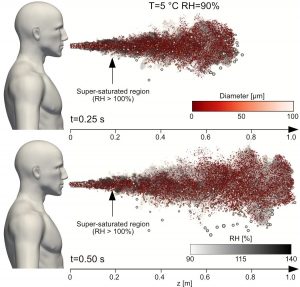 Pathogen-bearing droplets exhaled during respiratory events such as breathing,
speaking, coughing and sneezing are the main source in transmitting infectious diseases like SARS-Cov-2. It is no doubt that their fate in the turbulent humid clouds determines the tempol-spatial distribution of virus included so as to affect the infection risk eventually. We are simulating and modeling respiratory jet-sprays laden with polydisperse droplets utilizing both high-fidelity simulations and low-order modeling approaches. Our findings provide clear information and effective tools on helping policymakers to design guidelines.
Pathogen-bearing droplets exhaled during respiratory events such as breathing,
speaking, coughing and sneezing are the main source in transmitting infectious diseases like SARS-Cov-2. It is no doubt that their fate in the turbulent humid clouds determines the tempol-spatial distribution of virus included so as to affect the infection risk eventually. We are simulating and modeling respiratory jet-sprays laden with polydisperse droplets utilizing both high-fidelity simulations and low-order modeling approaches. Our findings provide clear information and effective tools on helping policymakers to design guidelines.
Reference(s):
- Wang, Jietuo, et al. “Modelling the direct virus exposure risk associated with respiratory events.” Journal of the Royal Society Interface 19.186 (2022): 20210819.
- Wang, Jietuo, et al. “Short-range exposure to airborne virus transmission and current guidelines.” Proceedings of the National Academy of Sciences 118.37 (2021)
Micro-Physics of Martian Dust Storms
Collaborators: Lorenzo Martinuzzo, Prof. Francesco Picano and Federico Dalla Barba
 Martian dust storms are among the most severe phenomena in the Solar System and could strongly affect both manned and unmanned missions on Mars. The physics of these events is dominated by the interaction between atmosphere and rock particles deposited on the Martian soil. We start simulating this kind of multiphase flows with a Particle-Resolved Direct Numerical Simulation (PR-DNS) approach to investigate the Micro-Physics of particle motion. Then we move to the Large Eddy Simulation (LES) method, where the particle motion is described through models obtained by the analysis of PR-DNS data. LES allows us to simulate more complex configurations, capable of describing the Martian conditions.
Martian dust storms are among the most severe phenomena in the Solar System and could strongly affect both manned and unmanned missions on Mars. The physics of these events is dominated by the interaction between atmosphere and rock particles deposited on the Martian soil. We start simulating this kind of multiphase flows with a Particle-Resolved Direct Numerical Simulation (PR-DNS) approach to investigate the Micro-Physics of particle motion. Then we move to the Large Eddy Simulation (LES) method, where the particle motion is described through models obtained by the analysis of PR-DNS data. LES allows us to simulate more complex configurations, capable of describing the Martian conditions.
Three-phase flow in bioreactors
Collaborators: Alessandro Crescenzi, Prof. Francesco Picano and Federico Dalla Barba
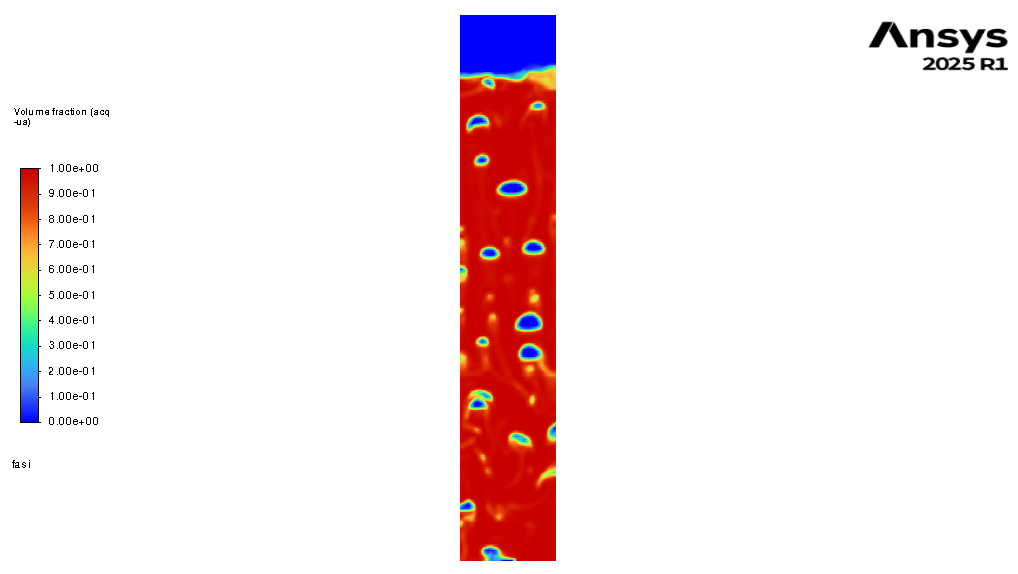 The field of bioreactors represents a subject of increasing interest, both in industrial applications, such as the capture of carbon dioxide, and in research applications, including the production of nutrients for space colonies.
The operation of these apparatuses involves a three-phase system that is extremely complex to study from a fluid-dynamic point of view.
Consequently, the problem is divided into distinct sections, each of which is subjected to detailed investigation through the execution of URANS simulations employing a range of configurations.
The simulations encompass chemical reactions for the production of species of interest, two-way coupling and DEM models.
The field of bioreactors represents a subject of increasing interest, both in industrial applications, such as the capture of carbon dioxide, and in research applications, including the production of nutrients for space colonies.
The operation of these apparatuses involves a three-phase system that is extremely complex to study from a fluid-dynamic point of view.
Consequently, the problem is divided into distinct sections, each of which is subjected to detailed investigation through the execution of URANS simulations employing a range of configurations.
The simulations encompass chemical reactions for the production of species of interest, two-way coupling and DEM models.
Fluid dynamics models of martian atmosphere
Collaborators: Martino Beccari, Andrea Bottacin Busolin and Prof. Francesco Picano
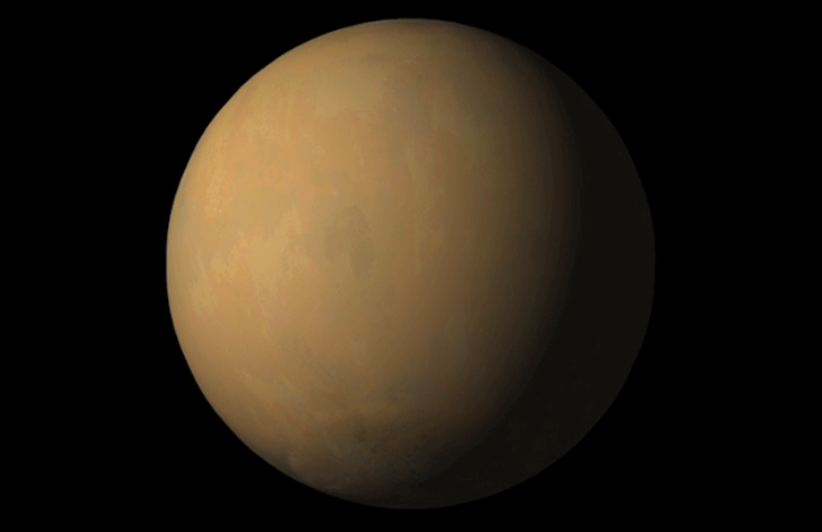 Fluid dynamics models can help to understand the complex climate dynamics of Mars, in
particular dust storms can pose a threat for missions on the ground.
These storms arise from complex interactions between turbulent atmospheric flows and surface dust,
which are first analyzed using high-resolution, particle-resolved simulations to uncover the micro-physics of dust lifting.
The detailed insights are then scaled up with Large Eddy Simulation (LES) techniques to model the turbulent and variable Martian atmosphere accurately,
enabling predictions of storm initiation, growth, and decay.
Fluid dynamics models can help to understand the complex climate dynamics of Mars, in
particular dust storms can pose a threat for missions on the ground.
These storms arise from complex interactions between turbulent atmospheric flows and surface dust,
which are first analyzed using high-resolution, particle-resolved simulations to uncover the micro-physics of dust lifting.
The detailed insights are then scaled up with Large Eddy Simulation (LES) techniques to model the turbulent and variable Martian atmosphere accurately,
enabling predictions of storm initiation, growth, and decay.
